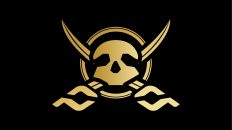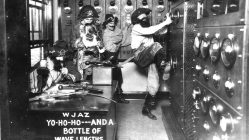“There’s a big open sea today. No land to be seen all the way to the horizon. There is however another boat on that horizon. It’s becoming obvious it certainly must have a longer waterline because throughout the day it is moving closer. It’s probably just another trading ship.
I am having to keep an eye on though. The Caribbean is known for piracy. I just have to get to Providence and all will be good.
The boat, a very large boat, keeps closing. And closing. I am really starting get a little concern…especially when I see the flag. It’s now so close I see the flag with my glass.
I don’t like what I see at all.
The flag shows a skeleton holding a hourglass in one hand and a spear in the other that he is using to stab a heart. Now I know it’s Blackbeard and the boat approaching is the Queen Anne’s Revenge.
I now know I will not live out the day.”
That was not an uncommon version of what took place from around 1817- 1818.
Blackbeard, in spite of the fact that there were other pirates worse, has such a storied legacy in our minds. He was a man that wouldn’t take a pardon at one point. And…yes, he was bloodthirsty and violent, but one hell of sailor.
Edward Teach was better known as Blackbeard, and he ripped the seas from the Caribbean, the coast of Mexico, and guess what? He even sailed up and raped the Eastern North America. To be called legendary you have to act legendary, and he did it in about a year. Think about that. A legend in about a year. We still think of him as debatably the most famous pirate ever. How much of what is said is true?
Well most of what is said is true, but what is false?
The most famous, and the truth about pirates in general is there is no buried treasure. Quite simply, why would you pirate a boat, sail back out to sea, away from all legal fences that would take your money away. Why not just take it with you? Buried treasure is sincerely unlikely. I think we have talked about the movie “Treasure Island.” Remember Israel Hands? That man was Blackbeard’s bosun. No, most of what pirates took were things they could turn quickly like sugar, cocoa, and virtually no gold, although certainly not unheard of.
There is a continuing thing about Blackbeard swimming around the ship three times at his death. While that is completely crazy, especially since he had no head, if anyone could pull that off it would be Blackbeard. The idea is almost ludicrous but factor in this. On the day of his death, November 22, 1718, coincidentally the same day Kennedy was assassinated, Blackbeard sustained at least five-gun shots, and another twenty plus sword cuts before he dropped.
Okay, this is brilliant and weird. Blackbeard hardly cut his hair and it is reported he would set his hair of fire before going to battle. Not true, however, he would put little candles or even pieces of fuse. The smoke was distinctly intimidating.
Now, bearing in mind Blackbeard’s infamy and popularity, one would think he is the most successful and wealthy pirate ever.
That is not so true.
He wasn’t actually close during his generation. Nope, Black Bart holds that distinction. He lived 1682 – 1722, a long time back in that day, and during his time he captured literally hundreds of boats. He also literally had a fleet of pirate ships. Make no mistake though, Blackbeard scared the hell out of a lot sailors and merchant captains.
There is a rumor about Blackbeard retired for a while and that is mostly true. The summer of 1718 saw Blackbeard run his ship aground into a sandbar and lost the vessel. Not long after, he and about 20 men dropped in on the then governor of North Carolina, Charles Eden, and accepted a pardon. He went about daily living no different from anyone else for while but eventually to fell back into his old ways.
When he went back into business this time, he had a partner. That guy was none other than the governor himself. With Charles Eden he could go wild, and as long as he shared the spoils, everything was great.
One of the most common tales is that he kept a journal of all his misbehavior. This is completely untrue. A captain himself, a writer named Charles Johnson, who wrote about piracy around the time Blackbeard was alive, stated a journal existed. The reality is, no writings were ever found.
While Blackbeard’s piracy only lasted about two years, he made an impact on history, inspiring everything from books to movies. Little is known about his youth other that he was born somewhere around Bristol, England and that he went to the high seas at a very young age. He was a privateer, a legalized pirate, during the Spanish Succession where he robbed ships regularly right up to when the war ended.
Apparently, he loved his line of work and kept robbing, like many privateers who no longer had a job. When 1716 rolled around Teach was serving Benjamin Thornigold and he made the long journey to the West Indies. From there, next step, the Americas.
One of the reasons he is so famous here in America is that he opened his office in North Carolina. He loved the outer banks, partially because he could anchor his ships in the shallow waters which prevented other ships from attacking him, and of course the warmer weather and water factored into the equation. He could also block the inlet and rob at will any ship trying to leave or come ashore.
November of 1718 smacked Blackbeard in the face. A man named Spotswood got fed up with him and issued a bounty. Between the reward, which came with a dead or alive statement, and the weariness of the robberies, Blackbeard’s time was nearing its conclusion. Lieutenant Governor Alexander Spotswood enlisted British soldiers to help hunt Teach down. The catch here is that Spotswood was the lieutenant governor of Virginia and the Carolina shore was way out of his jurisdiction.
Spotswood engaged Lieutenant Robert Maynard, a man seasoned with numerous ocean miles in his logbook. Two ships set sail for the Carolina coast, The Jane and The Ranger. Maynard sailed into the leeward side of Ocracoke on November 21, 1718 and anchored closely to Blackbeard, waiting until morning to approach, but the pirates saw them coming in the light winds while trying to navigate the shallow waters Blackbeard knew well. Meanwhile the pirates pulled anchor and Maynard’s ships ran aground.
Out came the oars and Maynard’s troops started chasing the pirate ships. According to Captain Johnson, the captain of The Ranger, a serious, rude shouting match ensued. This is what is said to have transpired:
“Black-Beard hail’d him in this rude Manner: Damn you for Villains, who are you? and from whence come you? The Lieutenant make him Answer, You may see by our Colours [the flags that identified a ship] we are no Pyrates. Black-beard bid him send his Boat on Board, that he might see who he was but Mr. Maynard reply’d thus; I cannot spare my Boat, but I will come aboard of you as soon as I can, with my Sloop. Upon this Black-beard took a Glass of Liquor, & drank to him with these Words: Damnation seize my Soul if I give you Quarters [a place to stay], or take any from you. In Answer to which, Mr. Maynard told him, that he expected no Quarters from him, nor should he give him any.”
Needless to say, that exchange did little to engender either person to the other. Maynard went back and freed his ships from the shallows, and as he approached Teach literally unloaded a broadside volley that killed several and wounded others.
Teach’s ship were very well endowed with large cannons, and the crew opened up at very close range with all the guns on one side simultaneously. This caused Maynard to send the crew to the shadows and out of sight.
This caused the confident pirate to believe the exchange was over. The broadside attack had indeed damaged the vessel and everything went quiet. It was time to board.
He boarded The Jane and was immediately confronted by Maynard’s soldiers. This would be his Swan Song. In spite of fighting fiercely, he was cut over twenty times, the last cut relieved him of his head according to Captain Johnson.
This was a big deal. I mean a really big deal because Blackbeard was as much a hero as a villain. The press of the day loved him and romanticized him. Later, the Boston News Letter posted what is supposed to be an accurate representation of Teach’s last battle:
“Maynard and Teach themselves began the fight with their swords, Maynard making a thrust, the point of his sword went against Teach’s cartridge box, and bended it to the hilt. Teach broke the guard of it, and wounded Maynard’s fingers but did not disable him, whereupon he jumped back and threw away his sword and fired his pistol which wounded Teach. Demelt [another sailor] stuck in between them with his sword and cut Teach’s face pretty much; in the interim both companies engaged in Maynard’s sloop, one of Maynard’s men … engaged Teach with his broad sword, who gave Teach a cut on the neck, Teach saying well done lad; [the man] replied If it be not well done, I’ll do it better. With that he gave him a second stroke, which cut off his head, laying it flat on his shoulder.”
And the inevitable had tapped the clock and Teach’s time had come. They gave little thought to anything but the money and the mission accomplished, and threw Teach’s headless corpse overboard. They took the head and mounted it on the bowsprit of Maynard’s boat. This was concrete that they had indeed accomplished what they had set out to do. It was money in the bank.
On November 21, 1996 Queen Anne’s Revenge, the 103 foot, forty-cannon flagship that had been lost on a sandbar off the coast was found. It had taken with it all the little facts of pirate’s daily living. There was no gold, no loot, and few things that showed what it was like to plunder and pillage in the early eighteenth century. Most likely, Teach grabbed his loot and ran.
What was found was those seemingly innocuous little details that had been lost with the sinking. There were little things like a chest full of medicines. One might think this was an “in case of” measure, but the reality was it had been received as a ransom payment. The big deal was it showed distinct insight about how they took care of people in that day.
Along with the chest, there was a bell dated 1709, cannons, large anchors, and after five years they firmly believed it was the flagship of the eighteen century equivalent of Al Capone. Come to think of it, maybe Al Capone was a twentieth century Blackbeard.
By Captain Lee Clymer









Add comment